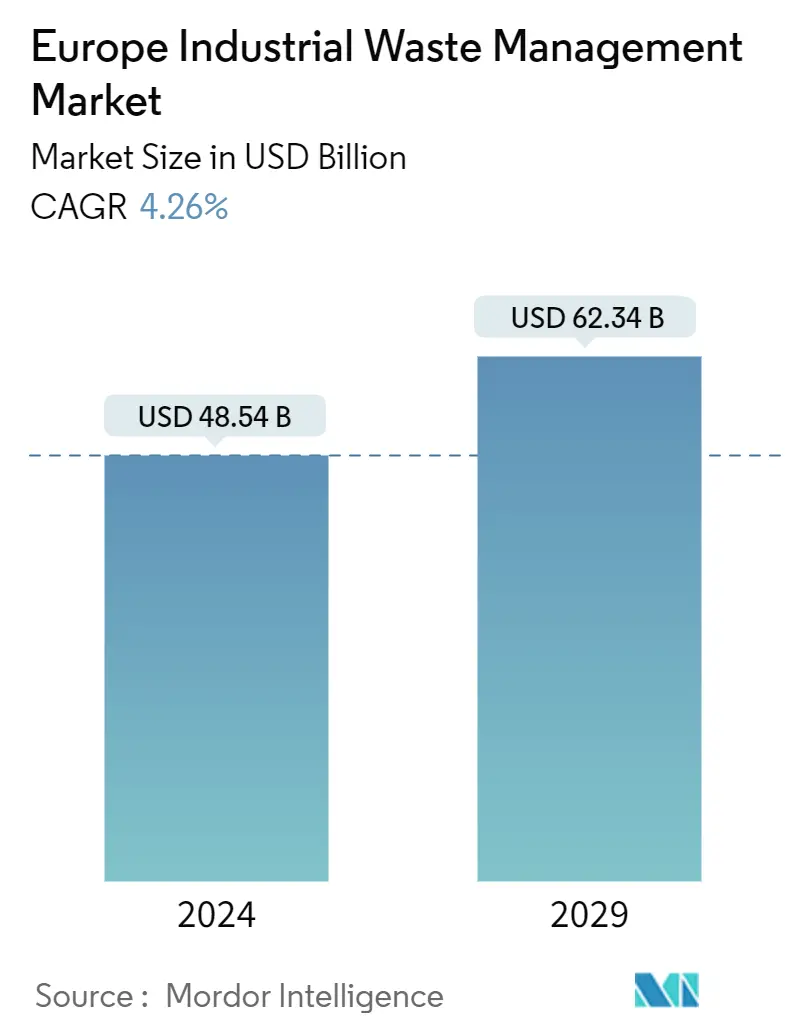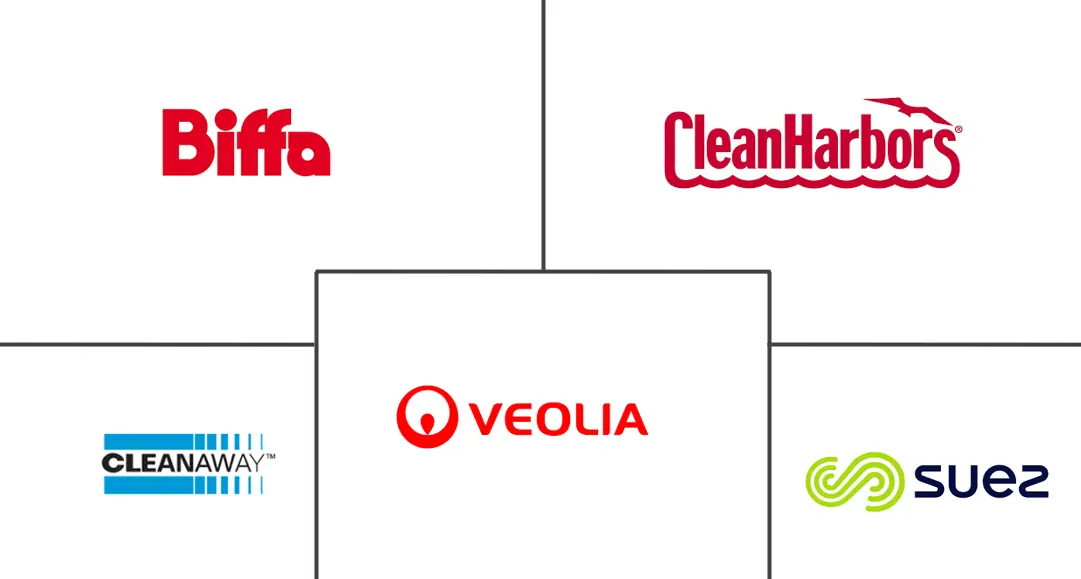Market Size of Europe Industrial Waste Management Industry

| Study Period | 2020-2029 |
| Base Year For Estimation | 2023 |
| Market Size (2024) | USD 48.54 Billion |
| Market Size (2029) | USD 62.34 Billion |
| CAGR (2024 - 2029) | 4.26 % |
| Market Concentration | Low |
Major Players
*Disclaimer: Major Players sorted in no particular order |
Need a report that reflects how COVID-19 has impacted this market and its growth?
Europe Industrial Waste Management Market Analysis
The Europe Industrial Waste Management Market size is estimated at USD 48.54 billion in 2024, and is expected to reach USD 62.34 billion by 2029, growing at a CAGR of 4.26% during the forecast period (2024-2029).
- The European Union has been recognized for its worldwide leadership in waste management. Some of the world's highest recycling rates for municipal waste are reported by EU Member States, such as Germany, Italy, and Austria. The waste management sector shall be responsible for all aspects of the waste cycle, which includes collection, transport, processing, disposal, and recycling of materials destroyed. French businesses Veolia and Suez and UK-based Biffa PLC are all among the largest waste management companies worldwide based on revenue.
- In its Member States, the European Union has different practices for the management of waste. The EU waste policy is aimed at contributing to the recycling economy by resource extraction of quality resources from waste. The EU would like to promote the prevention of waste and the re-utilization of products as much as possible. Recycling, including composting, is preferred by the EU if recycling is not possible, followed by the use of waste to generate energy.
- The recycling rate of urban waste in the EU has slowly improved over a number of years and now stands at 49%, as indicated by industry reports published in 2024. Nevertheless, 24% of municipal waste is disposed of in landfills. The recycling rates for other specific waste streams vary, from 64% of total packaging to 39% in electrical and electronic waste.
- In order to support a more Circular Economy in the European Union, a number of bold recycling targets have been set over the next decades. At 60% of municipal waste generated by 2030, EU Member States are now legally obliged to recycle or prepare for reuse. In accordance with the European Commission's Waste Framework Directive, residual municipal waste should be reduced by 50% in that same year to approximately 56.5 million tonnes.
Europe Industrial Waste Management Industry Segmentation
Industrial waste management is the process of collecting, transporting, treating, and disposing of industrial waste. This waste can include contaminated soil, dry pesticides, and chemical waste.
The European industrial waste management market is segmented by type (construction and demolition waste, manufacturing waste, oil and gas waste, and other waste (chemical waste, mining waste, agriculture waste, nuclear waste), service (recycling, landfill, incineration, and other services), and country (Germany, France, United Kingdom, Spain, and Italy). The report offers market sizes and forecasts in value (USD) for all the above segments.
| By Type | |
| Construction and Demolition | |
| Manufacturing Waste | |
| Oil and Gas Waste | |
| Other Waste (Chemical Waste, Mining Waste, Agriculture Waste, Nuclear Waste) |
| By Service | |
| Recycling | |
| Landfill | |
| Incineration | |
| Other Services |
| By Country | |
| Germany | |
| France | |
| Italy | |
| United Kingdom | |
| Spain | |
| Rest of Europe |
Europe Industrial Waste Management Market Size Summary
The European industrial waste management market is poised for significant growth, driven by the region's commitment to sustainable waste practices and circular economy principles. The European Union (EU) has established itself as a global leader in waste management, with member states like Germany, Italy, and Austria achieving high recycling rates. The EU's waste policy focuses on resource recovery, waste prevention, and product reuse, with recycling and energy recovery as preferred options. The market is characterized by the presence of major players such as Veolia, Suez, and Biffa PLC, who are at the forefront of innovative waste management solutions. The construction and demolition sector, along with manufacturing and healthcare, contribute significantly to waste generation, with construction waste alone accounting for a substantial portion of total waste in the EU.
The market landscape is competitive, with companies and startups alike embracing the Zero Waste philosophy, which emphasizes reducing, reusing, and recycling waste. The EU's regulatory framework, including directives like the Battery Directive, mandates separate collection and recycling of specific waste streams, further bolstering the market's growth prospects. Notable developments include Veolia's expansion of its operational sites in France and Evonik's collaboration with Remondis Group to enhance chemical recycling processes. These initiatives reflect the industry's ongoing efforts to innovate and adapt to evolving environmental standards and consumer expectations, positioning the European industrial waste management market for continued expansion in the coming years.
Europe Industrial Waste Management Market Size - Table of Contents
-
1. Market Insights
-
1.1 Current Market Scenario
-
1.2 Government Regulations and Initiatives
-
1.3 Technological Trends and Automation Insights
-
1.4 Insights on the Industrial Waste Production
-
1.5 Impact of the COVID-19 Pandemic on the Market
-
-
2. Market Segmentation
-
2.1 By Type
-
2.1.1 Construction and Demolition
-
2.1.2 Manufacturing Waste
-
2.1.3 Oil and Gas Waste
-
2.1.4 Other Waste (Chemical Waste, Mining Waste, Agriculture Waste, Nuclear Waste)
-
-
2.2 By Service
-
2.2.1 Recycling
-
2.2.2 Landfill
-
2.2.3 Incineration
-
2.2.4 Other Services
-
-
2.3 By Country
-
2.3.1 Germany
-
2.3.2 France
-
2.3.3 Italy
-
2.3.4 United Kingdom
-
2.3.5 Spain
-
2.3.6 Rest of Europe
-
-
Europe Industrial Waste Management Market Size FAQs
How big is the Europe Industrial Waste Management Market?
The Europe Industrial Waste Management Market size is expected to reach USD 48.54 billion in 2024 and grow at a CAGR of 4.26% to reach USD 62.34 billion by 2029.
What is the current Europe Industrial Waste Management Market size?
In 2024, the Europe Industrial Waste Management Market size is expected to reach USD 48.54 billion.

